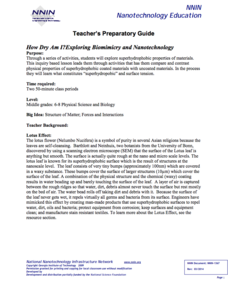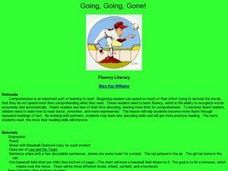Curated OER
Wet or Dry Experiment
Practice the scientific process by testing whether mealworms prefer a wet or dry environment. This is an engaging experiment to use as an example of how to go through the steps of the scientific method. Elementary schoolers can work in...
Curated OER
The Big Wet
Students complete a research project. In this climate lesson, students learn about the climate "tropical wet and dry" found in Australia. Students work in groups to research aspects of this climate and then create a class presentation.
California Academy of Science
Dry My Laundry!
Meant to be a pre-field trip lesson, this can also serve as a cute and simple activity to use when your little ones are learning about evaporation or surface area. The children cut tiny t-shirts out of paper towel material, wet them, and...
PBS
Curious George: Sand and Soil
Two sensory tables—wet and dry—allow scholars to use their sense of sight, touch, and smell to observe the changes when the dirt mixes with water. A short video relates the STEM learning experience to a fun video clip where Curious...
Curated OER
The Big Wet
Students research areas of Australia and other parts of the world characterized by a tropical wet and dry climate.
Curated OER
Electric Current
Necessary vocabulary for exploring electric current is detailed in these slides. Circuits, voltage, wet and dry cell and batteries are defined, making this a great overview on the subject. It could also serve as a complement to a lesson,...
Curated OER
Dry Season and 'Green' Season in Costa Rica
Students explore the seasonal changes in Costa Rica. In this dry season lesson students use the Internet to locate science data then generate data for precipitation.
Curated OER
Dripping Wet or Dry as a Bone?
Students use a sponge and water model to explore the concept of relative humidity and create a percent scale. They define humidity and saturation, build a simple humidity/saturation model, collect, predict and interpret data, and create...
Curated OER
Wet Water, Dry Land
Students observe and examine relationship between landforms and bodies of water, recognizing differences between them. Students then define island, peninsula, isthmus, archipelago, lake, bay, straight, system of lakes, and identify land...
Teach Engineering
Superhydrophobicity – The Lotus Effect
Discover and demonstrate the Lotus Effect and superhydrophobic surfaces with the eighth installment of a nine-part series that teaches scholars about surfaces that exhibit superhydrophobicity. The lesson continues also describes...
National Nanotechnology Infrastructure Network
How Dry am I? Exploring Biomimicry and Nanotechnology
Help your classes feel like they can walk on water! An engaging inquiry-based lesson has young scholars experiment with different surface coatings. They make observations about their properties and how they relate to the surface tension...
NOAA
A Watery World
With about 70% of the earth's surface covered in oceans, it's fair to say that we live in a very wet world. Young scientists gain a better appreciation of this fact as they use maps to identify the world's ocean basins in the first...
Curated OER
What Does the Inside of a Seed Look Like?
First graders study seeds. In this biology lesson, 1st graders observe the differences between dry and wet seeds and draw what is inside a seed after peeling off the outer coat of one of the seeds.
Curated OER
Is Dry Cleaning Dangerous?
In this dry cleaning activity, students read about the chemicals used to clean clothes and the alternative possibilities for dry cleaning use. Students answer three critical thinking questions about the dangers of the chemical agents...
Curated OER
Going, Going, Gone!
Sixth graders use the scientific method to test variables of evaporation. In this evaporation lesson plan, 6th graders test a wet handprint on a paper towel and relate this experiment to weather conditions.
Curated OER
The Story of Rocks
In this science worksheet, students learn to classify rocks as igneous, sedimentary or metamorphic. Students learn what a mineral is and the stages of the rock cycle. Students experiment with samples of 7 minerals and record data on...
Curated OER
Measuring Relative Humidity: A Psychrometer
In this scientific investigation worksheet, students follow the provided procedures to examine the temperature reading of wet and dry thermometers and then respond to 5 questions.
Curated OER
Observing Rocks
Fifth graders explore the various properties of earth and rocks. They play "Twenty Questions" with the teacher, and analyze a rock using a magnifying glass. They record their rock observations and list the differences between the wet...
Curated OER
Redox and Electrochemistry
In this redox and electrochemistry worksheet, students identify the anode in electrode pairs of electrochemical cells. They also describe how a lemon battery works and how wet and dry voltaic cells work.
Cornell University
Making a Battery
Don't be shocked when your class has a blast making their own batteries! Science scholars examine a dry cell battery, then design and construct a wet cell battery. The activity guides them through the parts of a battery, the variables...
Curated OER
Stained Glass Flowers
Elementary and middle schoolers create decorative flowers using wire armatures and a special paint that remains flexible when it dries. The results from this project are stunning, but the materials needed may be tough to track down. An...
DiscoverE
Shaky Ground
You're on solid ground if you decide to use the resource. A simple activity has young engineers investigate the problem of liquefaction. A battery placed on dry sand will stay standing—but not if scholars add water to the cup.
Curated OER
#21 Films, Fibers, and Solubility
Students are introduced to how the differences in solubility of materials are used in the manufacture of fibers and films. They are also introduced to the various processes used to make films and fibers. Pupils prepare fibers using wet...
Teach Engineering
Dress for Success
Dressing for success is not always about looking sharp. Sometimes it is about staying warm and dry. Present your class with an activity that challenges groups of pupils to design a layered material for blizzard conditions. The teams test...
Other popular searches
- Wet and Dry Environments
- Project Wet and Dry
- Wet and Dry Concepts
- Wet and Dry Climates
- Wet and Dry Write
- Wet and Dry Enviroments
- Environment Wet and Dry
- Dry Cell Wet Cell
- Wet and Dry Vocabulary
- Wet and Dry Weather
- Wet and Dry Environments Unit
- Wet and Dry Enviroenments

























